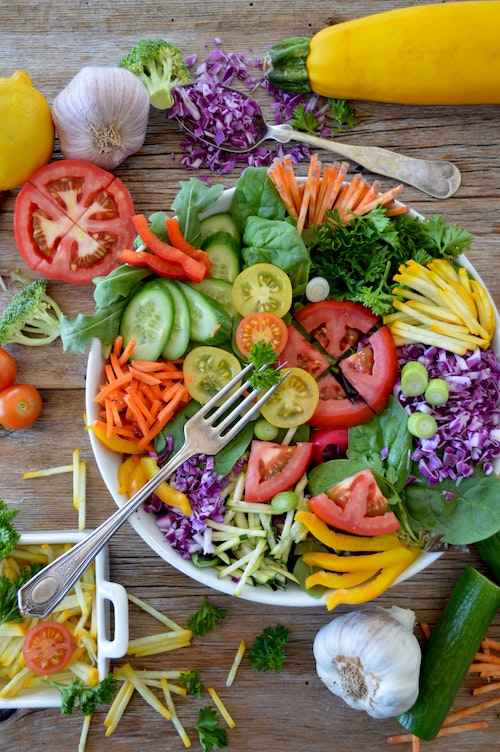A lot of women come to me confused about what to eat. There’s a lot of conflicting information out there and it can be hard to figure it all out! If you’ve been wondering how to eat more plants, keep reading!
In his most recent book, Darin Olien (of Netflix ‘Down to Earth’ fame) says this:
“How can it be that every beast, every fish, every insect – every other critter on the face of the planet – can figure this out so easily, and yet here we are, still wondering [what to eat]?”
Well, as it turns out, we do know! We need to eat more plants. Welcome to the latest installment of…
Blue Zones Secret #3: Eat More Plants.
If you remember, I am doing a 9-post series based on my recent read: Blue Zones: 9 Lessons for Living Longer From the People Who’ve Lived the Longest.
And, as I mentioned, this one is Secret #3: Eat More Plants.
If you’ve just come across this, you can start at the beginning with Secret #1 by clicking here.
Of the 5 cultures studied in the Blue Zones, most ate a little meat but a large majority of their daily caloric intake came from plants: fruits and veggies, nuts, seeds, whole grains and legumes.
In the U.S., we tend to think protein is KING and we eat a lot of it – WAY more than our body needs or knows what to do with*. On top of that the majority of our animal-based foods are highly processed and loaded up with antibiotics, hormones, and other toxins.
Even when the people in the Blue Zones do eat meat, it’s a much cleaner version than what most Americans get. But, aside from that, a diet rich in whole grains and legumes (beans and lentils) has so many benefits!
Here are a few benefits of eating whole grains and legumes:
- Great source of fiber, which helps detox the body naturally
- Lots of antioxidants
- Potential anti-cancer agents from insoluble fiber
- Reduce cholesterol
- Diets rich in legumes are associated with fewer heart attacks and less
colon cancer - Legumes are an excellent source of non-animal protein
Here are the Blue Zone tips for incorporating Secret #3 into your life:
Eat at Least 6 Servings Daily
Blue Zone diets always include at least two servings of vegetables at each meal. Add to that the 2-3 servings of suggested fruit per day and we reach the 6-8 servings recommended by most medical and nutritional experts. Limit Intake of Meat*
Everyone is saying it: less meat is proven to increase a healthy lifespan. Try limiting meat to twice per week and ensure your portions are no larger than a deck of cards.
Limit Intake of Meat* And Eat More Plants
Everyone is saying it: less meat is proven to increase a healthy lifespan. Try limiting meat to twice per week and ensure your portions are no larger than a deck of cards.
Showcase Fruits & Vegetables To Eat More Plants
Instead of hiding produce where no one can see it, have a beautiful, enticing bowl of it on the counter for easy snacking.
Lead with Beans
Beans are the cornerstone of Blue Zone diets. Aim to have beans or non-GMO, organic tofu as the centerpiece of most lunches and dinners.
Eat Nuts Every Day
Nuts are the new ‘it’ food! Studies have shown that people who eat nuts at least five times per week had HALF the rate of heart disease as those who rarely at nuts. Crazy, right?! A serving is about 2 ounces so, a handful each day is perfect.
Stock Up To Eat More Plants
Keeping good foods around means you’re more likely to eat them! Having snack bags filled with 2-ounce portions of nuts, fruit and veggies on the counter (or cut up in the fridge) helps ensure it's easy to grab-and-go. You can even buy canned beans and legumes for fast dinners OR cook and freeze them in 1-cup increments.
And there you have it – Secret #3 for living a long, healthy life! Stay tuned for the next secret. Hope you enjoyed this installment 🙂
P.S. Reminder – if you are incorporating the Blue Zones Secrets, go easy!
Here are some tips on making new changes:
- Contrary to popular belief, it does not take 28 days to build a new habit – it takes 66 days (on average). As you add a new habit, remember that it takes a couple of months to build up that new muscle, so don't give up
after a week or two! - Pick low-hanging fruit. Each of the 9 lessons/secrets is valuable but start with the ones that are easiest for you so you gain some traction and confidence.
- Try it with a friend. Having an accountability partner helps ensure you stay on track.
- Don’t incorporate more than 3 secrets at a time. Start with the ones you are likely to have the best chance of success with and then add more as that pattern of success emerges.
*Adults 19 years and older only need .8 grams of protein for every kilogram (2.2 lbs) of weight. For most of us, that’s about 50-80 grams or 1.8-2.8 ounces per day. Not much! Our body can’t store protein so what is in excess
gets converted to fat.

